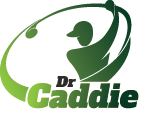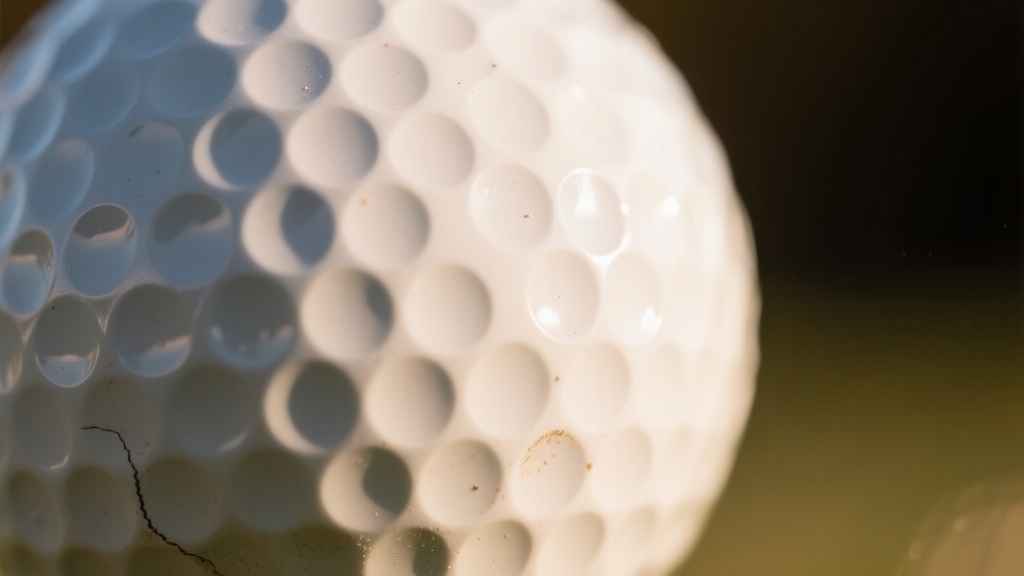You’ll find most golf balls have between 300 and 500 dimples, with an average near 336, carefully designed to optimize aerodynamics. These dimples, typically 0.13 to 0.16 inches wide and about 0.010 inch deep, create turbulent airflow that reduces drag and improves lift.
Different brands vary patterns and counts to tailor flight, spin, and control for players at all levels. Exploring how these precise designs influence performance reveals the science behind every shot.
- Key Takeaways
- Typical Range of Dimples on Golf Balls
- How Dimples Enhance Golf Ball Aerodynamics?
- Variations in Dimple Patterns by Brand
- Impact of Dimple Count on Ball Flight and Spin
- Differences in Dimples for Beginner vs Advanced Players
- Unique and Record-Breaking Dimple Counts
- The Evolution of Dimple Design Over Time
- Technical Specifications of Golf Ball Dimples
- How Dimple Design Influences Golf Ball Performance?
- Frequently Asked Questions
- Choosing the Right Dimple Pattern for Maximum Performance
Key Takeaways
- Standard golf balls typically have between 300 and 500 dimples, with an average around 336 dimples.
- Popular models like Titleist Pro V1 usually feature about 352 dimples, while Pro V1x ranges from 328 to 388.
- Dimple counts vary widely, from as few as 250 on some models to over 1,000 on experimental designs.
- The number of dimples is optimized to influence aerodynamics, affecting lift, drag, spin, and flight stability.
- Dimple size generally ranges from 0.13 to 0.16 inches in diameter with depths near 0.010 inch for optimal performance.
Typical Range of Dimples on Golf Balls
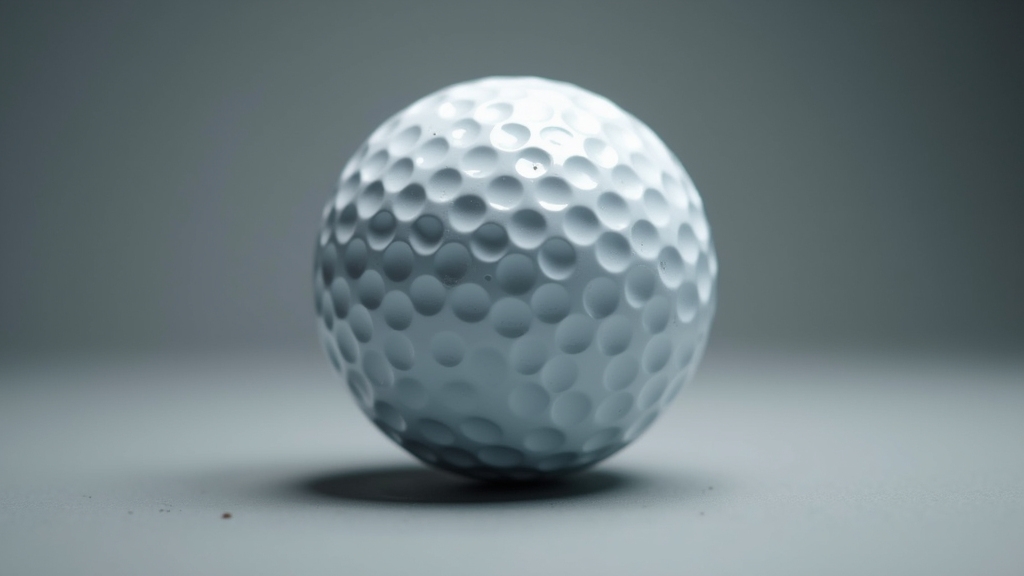
Although the number of dimples on golf balls varies by model and manufacturer, you’ll typically find between 300 and 500 dimples on standard balls. The average count hovers around 336, with popular models like the Titleist Pro V1 having approximately 352 dimples and the Pro V1x ranging between 328 and 388. The dimple design also influences the ball’s flight path and feel, which are key factors in performance.
Experimental balls may exceed 1,000 dimples, but most manufacturers optimize within 220 to 430 dimples for consistent performance.
Dimple quantity correlates with ball type: distance balls often feature fewer dimples to reduce drag, while control balls employ higher counts with intricate patterns to enhance spin and accuracy. Manufacturers also vary the dimple depth and layout to tailor flight characteristics for different playing styles.
How Dimples Enhance Golf Ball Aerodynamics?
When you examine a golf ball’s surface, you’ll notice that its dimples play a crucial role in enhancing aerodynamics by manipulating airflow patterns.
Dimples induce a turbulent boundary layer, energizing the airflow near the surface and delaying flow separation. This reduces the low-pressure wake behind the ball, markedly cutting pressure drag. Most golf balls feature between 300 and 500 dimples, which is optimal for aerodynamic performance. Choosing golf equipment with appropriate surface texture can similarly impact play quality.
Although turbulence slightly increases friction drag, the net effect halves total drag compared to a smooth ball. Dimples act as artificial turbulators, creating dual airflow layers—a faster top layer and a slower turbulent layer—improving drag reduction.
They also enhance lift by intensifying the Magnus effect caused by backspin, optimizing trajectory. Engineers tailor dimple size, shape, and distribution to stabilize the boundary layer, maximizing distance and accuracy by balancing lift and drag forces precisely.
Variations in Dimple Patterns by Brand
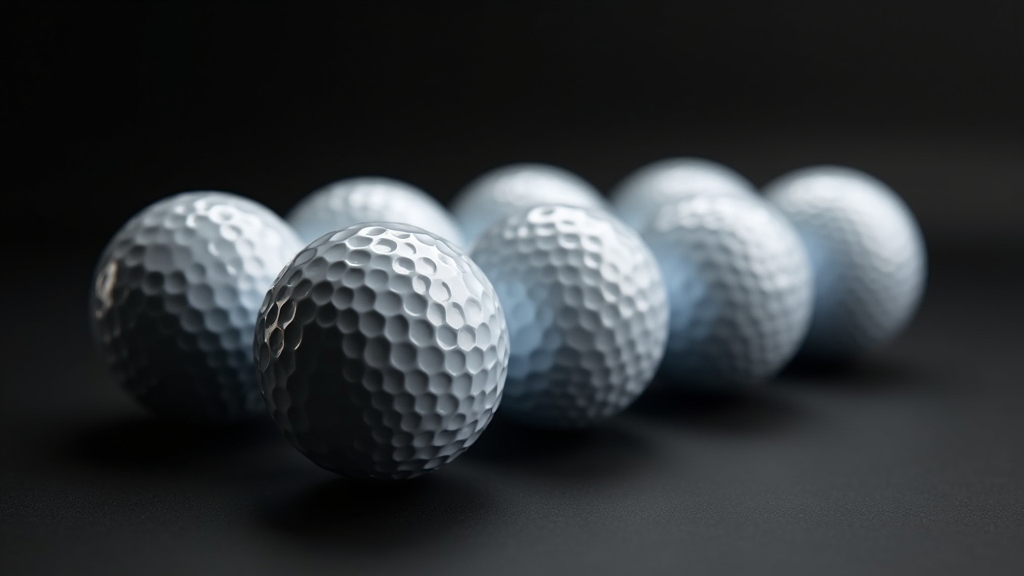
Did you know that each golf ball brand has its own specific dimple counts? It’s pretty fascinating! They do this to optimize the ball’s aerodynamics for the kind of performance they’re targeting.
But it doesn’t stop there. The unique dimple geometries and arrangements really help to fine-tune the flight characteristics of the ball. This means they’re balancing all sorts of factors, like distance, spin, and control. For example, Titleist offers 12 different dimple patterns, ranging from 312 to 440 dimples, to cater to various player preferences. These variations are similar to how golf ball markers use alignment features to enhance precision and accuracy for players.
When you dive into these design variations, it’s eye-opening to see how manufacturers really fine-tune their golf balls. They’re doing it all to meet the diverse needs of players out there. Pretty cool, right?
Brand-Specific Dimple Counts
Different golf ball brands adopt distinct dimple counts and patterns to optimize aerodynamic performance for various playing characteristics.
For example, TaylorMade models typically feature 322 dimples, balancing simplicity and distance emphasis. Callaway maintains a consistent 332 dimples across models, ensuring uniform aerodynamic traits. These design choices contribute to reliable ball flight metrics essential for consistent shot data.
Mizuno offers a broad range—from 272 dimples on the RB Tour to 566 on the RB566x, allowing tailored flight and spin profiles. It is important to note that dimple patterns impact spin and distance, contributing to different shot shapes and trajectories.
Bridgestone’s count varies between 272 and 372 dimples, with Tour B models ranging 326 to 338 dimples, incorporating aerodynamic refinements like mini dimples within standard ones. Such refinements can influence measurable parameters like ball speed and launch angle, which are precisely tracked in golf simulators.
Titleist’s Pro V1 line generally holds 352 to 388 dimples, while Wilson’s Ultra 500 reaches 500 dimples. These variations reflect each brand’s aerodynamic priorities rather than a linear correlation between dimple count and performance.
Unique Dimple Shapes
Although dimple count plays a crucial role, the geometry and arrangement of dimples have an even greater impact on a golf ball’s aerodynamic behavior. You’ll find that dimples aren’t simply round; brands like Bridgestone embed mini dimples within larger ones to fine-tune airflow and stabilize flight. This design approach parallels how golfers adjust their spin axis to influence ball trajectory.
Polara varies dimple depth latitudinally, producing self-correcting trajectories by shifting lift and drag forces across the ball’s surface. This patented design reduces hooks and slices by up to 75%, making it easier for golfers to maintain straighter shots.
Some manufacturers employ asymmetric patterns, adjusting dimple size and depth regionally to manipulate the spin axis and moment of inertia.
This strategic variation in dimple shape and layout optimizes turbulence generation, drag reduction, and lift control, directly affecting stability and distance.
Therefore, understanding these unique dimple configurations helps you appreciate how brand-specific designs tailor aerodynamic performance beyond mere dimple count.
Performance-Driven Dimple Design
When designing golf balls, brands tailor dimple patterns to optimize aerodynamic performance and flight stability rather than merely increasing dimple count. Proper customization and fitting, similar to golf grips, can significantly enhance overall control and consistency.
You’ll notice that TaylorMade balances simplicity with about 322 dimples, while Callaway holds steady at 332 for uniformity.
Mizuno experiments extensively, ranging from 272 to 566 dimples, pushing aerodynamic boundaries. Bridgestone varies from 272 to 372 dimples, sometimes placing mini dimples inside larger ones to refine airflow.
Titleist tests hundreds of patterns, focusing on custom designs for specific flight characteristics. The geometry of the pattern plays a crucial role in influencing flight more than the sheer number of dimples.
| Brand | Dimple Count Range |
|---|---|
| TaylorMade | ~322 |
| Callaway | 332 |
| Mizuno | 272 – 566 |
| Bridgestone | 272 – 372 |
| Titleist | 250 – 450+ |
Each pattern’s geometry impacts lift, drag, and spin, proving more dimples don’t guarantee better performance. Understanding these nuances parallels the importance of accurate measurement in golf equipment customization.
Impact of Dimple Count on Ball Flight and Spin
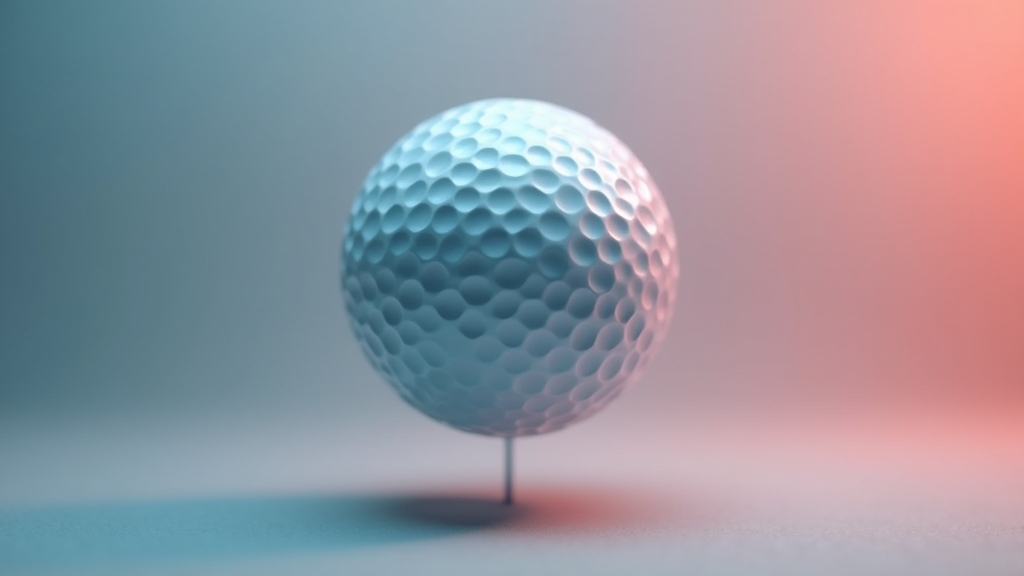
Because the number of dimples directly alters aerodynamic forces, it substantially affects a golf ball’s flight path and spin characteristics.
The number of dimples directly shapes a golf ball’s flight and spin through aerodynamic forces.
Increasing dimple count elevates surface drag, flattening the trajectory while extending hangtime. Conversely, fewer dimples reduce drag, producing a higher ball flight and potentially longer shots but with diminished control. This modulation in aerodynamic behavior complements how core compression influences overall ball performance.
This modulation influences lift by changing airflow patterns and boundary layer turbulence, thereby impacting spin rates indirectly. Higher dimple counts typically enhance spin, aiding precision and accuracy, especially on approach shots. The typical golf ball has around 336 dimples, but this number can range from 300 to 500 depending on design.
Lower counts favor distance by minimizing spin-induced drag. Manufacturers exploit these relationships, adjusting dimple numbers within the typical 300–500 range to fine-tune the balance between distance and control.
This optimizes aerodynamic efficiency for varied shot requirements without compromising flight stability or predictability.
Differences in Dimples for Beginner vs Advanced Players
You’ll notice that beginner golf balls usually have fewer dimples—around 300 to 350. This design helps reduce drag and maximize distance, which is super helpful for players with slower swing speeds. It’s all about getting those beginners to hit the ball further! Understanding how course layout influences play can also help beginners choose the right ball for different conditions.
Now, if you look at advanced players’ golf balls, you’ll see they feature a lot more dimples, sometimes up to 500. The patterns are more complex too. This design enhances spin and control, making it easier for skilled players to shape their shots with precision. Manufacturers often combine different dimple shapes and sizes to optimize performance for various playing conditions.
Dimple Count Variations
Although dimple count alone doesn’t determine a golf ball’s suitability, variations between beginner and advanced models markedly influence performance characteristics.
Beginner balls typically feature around 300 to 350 dimples, prioritizing durability and stable, forgiving play with shallower, larger indentations. These design choices help maintain control and comfort for less experienced players. In contrast, advanced balls range from 330 up to 500 or more dimples, incorporating intricate patterns and deeper dimples to optimize lift, drag reduction, and spin control.
For example, Titleist Pro V1 employs about 352 dimples, balancing distance and shot-shaping, while Wilson Ultra uses 500 dimples to enhance control. These differences reflect design objectives: fewer dimples simplify manufacturing and promote straighter shots ideal for novices. The number of dimples can even reach over 1,000 in some specialized models, setting records for maximum dimple counts.
Higher counts demand precision engineering, multi-layer constructions, and varied dimple shapes to meet advanced players’ demands for nuanced aerodynamic performance and responsiveness.
The dimples function primarily to reduce drag and increase lift by creating a thin air layer around the ball, which is crucial for the ball’s stable and predictable flight.
Impact on Ball Flight
How do dimple designs differ in their impact on ball flight for beginner versus advanced golfers?
Beginners benefit from shallower dimples that increase lift and launch angle, boosting carry and compensating for off-center hits. These simpler patterns reduce sidespin and enhance forgiveness, promoting straighter, higher trajectories. Additionally, shallow dimples create a thin airflow layer that reduces drag, helping beginners achieve longer and more stable shots. This design also complements the low compression of soft golf balls that many beginners use to maximize distance and control.
In contrast, advanced players require deeper, more complex dimple configurations that optimize drag reduction and stabilize flight at higher swing speeds. These patterns lower launch angles and favor penetrating trajectories, enabling precise shot-shaping and trajectory control.
Manufacturers engineer dimple geometry with micro-precision to balance lift, drag, and stability, tailoring designs to skill-specific demands. By selecting dimple depth, size, and pattern, you can align ball performance with your swing characteristics, maximizing distance or control depending on your proficiency level.
Spin and Control Differences
When optimizing golf ball performance for spin and control, dimple design plays a critical role tailored to player skill.
As you progress, you’ll notice that beginner balls have around 300 simpler dimples, reducing drag for distance but limiting spin control.
Advanced balls feature 400+ complex dimples with varied shapes and depths to enhance spin and shot precision.
Consider these key differences:
- Dimple depth: deeper dimples increase spin and lower trajectory, aiding control; shallower dimples favor higher flight and distance for beginners.
- Dimple count and pattern: more dimples create turbulent airflow stabilizing flight and enabling nuanced shot shaping. This turbulence helps manage aerodynamic forces, increasing lift, which counters gravity and prolongs the ball’s airborne time boundary layer.
- Edge sharpness: sharper edges boost lift and spin, essential for advanced players manipulating ball trajectory.
Understanding these factors helps you select balls that align with your skill and desired shot characteristics.
Unique and Record-Breaking Dimple Counts
While most golf balls feature dimple counts between 300 and 400, certain models stand out for pushing these numbers to unique extremes.
For instance, the Mizuno RB566 holds the record with 566 dimples, maximizing surface texture for aerodynamic fine-tuning.
Conversely, the Kira Boon ball by Kasco features an exceptionally low 250 dimples, showcasing minimalist design.
Titleist’s retired HVC model had 440 dimples, emphasizing denser patterns.
These extremes highlight manufacturers’ experimentation within USGA regulations, which place no direct limits on dimple counts or size.
However, you should note that performance doesn’t improve simply by increasing dimple quantity; optimal outcomes depend on precise geometry, depth, and arrangement.
Unique dimple counts reflect targeted aerodynamic strategies aiming to balance lift, drag, and stability for specific flight characteristics.
Most golf balls typically have between 300 and 500 dimples, with the common count around 336 dimples.
The Evolution of Dimple Design Over Time
Understanding unique dimple counts sets the stage for examining how dimple design has progressively refined over time.
Initially, golf balls were smooth until accidental indentations revealed performance benefits. Early 1900s innovations formalized dimple patterns, shifting from rough textures to engineered surfaces. Coburn Haskell’s rubber-core ball revolutionized golf in 1898, marking a significant milestone in golf ball design.
Today, the evolution hinges on aerodynamic optimization.
You should note these key developments:
- Transition from hand-carved, circular dimples to varied polygonal shapes enhancing airflow and stability.
- Introduction of precise molds and rubber cores allowing consistent, reproducible patterns tailored for specific flight characteristics.
- Use of computer modeling to refine dimple depth, size, and distribution, maximizing lift and minimizing drag.
This progression underscores a shift from serendipitous discovery to scientifically driven design, directly impacting golf ball flight efficiency and consistency.
Technical Specifications of Golf Ball Dimples
Since dimple design critically influences a golf ball’s aerodynamic performance, you should examine their technical specifications closely.
Typically, golf balls feature 250 to 500 dimples, averaging around 336, arranged symmetrically to ensure consistent airflow. Dimples measure between 0.13 and 0.16 inches in diameter with depths near 0.010 inch, maintaining uniformity to stabilize aerodynamic flow.
While most dimples are spherical, some models incorporate hexagonal shapes or alternate shallow and deep dimples to refine lift and drag characteristics. This symmetrical pattern also controls spin axis, mitigating hooks and slices.
Regulatory constraints, like the 1.680-inch minimum ball diameter, indirectly limit dimple sizing and count. Dimples are designed to create specific aerodynamic effects, which are critical for optimizing golf ball flight performance aerodynamic effects.
How Dimple Design Influences Golf Ball Performance?
The technical specifications of dimples set the foundation for their aerodynamic effects on golf ball performance.
When you analyze dimple design, three critical factors emerge:
- Lift and Drag: Dimples create a turbulent air layer that reduces drag by up to 50%. This enhancement increases flight distance while stabilizing the ball’s trajectory through lift. Research indicates that this reduction in drag is achieved by creating small turbulences behind the ball which allow for smoother airflow, significantly boosting performance.
- Spin and Trajectory Control: Variations in dimple depth and pattern directly affect spin rate. This allows you to tailor ball flight for precision or distance based on your playing style. Different models feature precisely calculated patterns that influence spin, height, and control to optimize play.
- Environmental Stability: Optimized dimple arrangements reduce lateral movement and improve airflow consistency. This helps maintain accuracy even in windy or fluctuating conditions. The arrangement and number of dimples, typically ranging from 300 to 450, are designed to enhance stability and reduce sinking during flight.
Frequently Asked Questions
How Are Dimples Manufactured on a Golf Ball?
You manufacture dimples on a golf ball by injecting liquid cover material into a mold cavity engraved with the dimple pattern.
The mold halves close tightly around the rubber core, applying heat and pressure to cure the cover and imprint dimples precisely.
After molding, excess material is trimmed, and the ball undergoes sanding and polishing to guarantee smooth, aerodynamic dimples.
This process assures consistent shape and optimized flight performance every time.
Do Dimples Affect Putting on the Green?
Yes, dimples can slightly affect putting, but the impact is minimal. When your putter strikes near a dimple edge, dimple deflection may cause small deviations in launch angle, typically between 0.06° and 0.15°.
However, because your putter compresses multiple dimples on impact, these effects usually average out. Overall, dimple patterns don’t considerably influence putting accuracy; factors like putter design and stroke consistency matter far more.
Can Damaged Dimples Impact Golf Ball Performance?
Think of your golf ball’s dimples as tiny aerodynamic architects shaping every flight. Yes, damaged dimples can seriously impair performance by disrupting airflow, reducing lift, and increasing drag.
This causes lower carry distances, inconsistent trajectories, and errant shots. You’ll notice decreased peak height and altered spin, which can send your ball offline.
To maintain precision and maximize distance, you should replace scuffed or worn balls instead of risking compromised aerodynamics.
Are There Environmental Effects on Dimple Effectiveness?
Yes, environmental factors substantially affect dimple effectiveness.
Exposure to marine environments, UV radiation, and mechanical abrasion can degrade dimple integrity, reducing aerodynamic efficiency.
Water and air flow conditions alter boundary layer behavior, changing drag and lift forces.
Temperature and fluid medium variations impact viscosity and flow dynamics, influencing dimple performance.
You must consider these variables since prolonged environmental exposure can diminish the dimples’ ability to optimize flight or hydrodynamic drag reduction.
How Do Dimples Influence Ball Visibility in Flight?
Imagine each dimple as a tiny sculptor shaping the ball’s flight canvas. They create turbulence, stabilizing airflow so you can track the ball’s path more predictably.
Dimples break light into subtle shadows and highlights, enhancing contrast against sky and ground backgrounds.
By reducing drag and maintaining spin, they prevent wobbling.
This gives you a smoother, steadier flight that’s easier to spot and follow through your swing and beyond.
Choosing the Right Dimple Pattern for Maximum Performance
Now that you’ve explored the subtle art of golf ball dimples, you’ll appreciate how these tiny textures quietly fine-tune your game.
Whether you prefer a classic pattern or a cutting-edge design, understanding dimple counts and arrangements lets you make informed choices without getting lost in complexity.
Remember, the interplay of aerodynamics and spin isn’t just science; it’s a gentle nudge toward optimizing your performance on the course.
